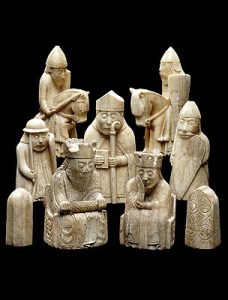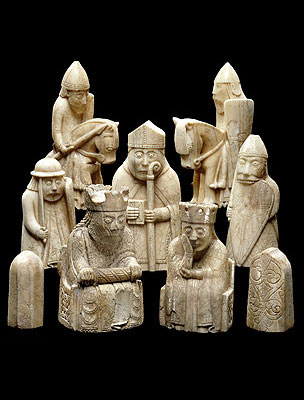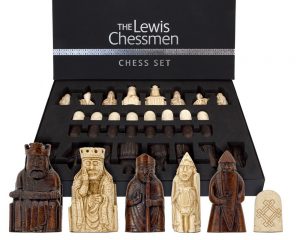
One of the most famous found treasures displayed at the British Museum are the Lewis Chessmen. In 2003, a special episode on BBC Television listed the top ten treasures discovered in Britain and the Lewis Chessmen made the list. They are surrounded with mystery, and continue to attract millions of visitors each year.
Below are 10 interesting facts about these iconic Chessmen. They are fascinating objects!
1)The Lewis Chessmen date to 1150-1200 AD
The Lewis Chessmen first made their mystifying appearance in 1831 when exhibited at a meeting of the Society of Antiquaries of Scotland by Roderick Ririe. They were an instant marvel and appreciated for their treasured position. The artifacts date back to between 1150-1200 AD and are some of the most valuable chess pieces in the world. Their exact value is difficult to determine because they are so extraordinary and are of extreme historical importance. They are one of a kind and definitely worth millions.
2)Most of the Lewis Chessmen are crafted from walrus ivory
The chess pieces are mostly carved out of walrus ivory, with only four made from whale teeth. They were discovered within a hoard of 93 total objects. 78 chessmen, 1 belt buckle, and 14 gaming disks. The chess pieces found consisted of 8 kings, 8 queens, 16 bishops, 15 knights, 12 rooks, and 19 pawns. This grouping suggests the hoard held 4 complete chess sets, and some of the missing pieces may have remained at the location where the others were found, or were destroyed or damaged during the time they lay buried.
3)The Lewis Chessmen were found in the Isle of Lewis
The hoard was discovered on the Isle of Lewis. However, there are conflicting reports on exactly where and in what manner. The most commonly given account is the hoard was found in a sand bank at Uig; after a storm had eroded the area away, revealing the treasure cache. It’s believed to have been buried there for safe keeping by a trader or traveling merchant who experienced some kind of mishap and never returned to retrieve them. But perhaps they were stolen loot and buried by thief? No one knows for certain.
Other accounts say they were found near an ancient nunnery or found in a small underground chamber used for storage. It is unclear exactly where they were found. It is also unclear who made them. The most accepted account is they originate in Trondheim, Norway. However, this is only a theory and their origins remain a mystery as well.
4) The British Museum and National Museum of Scotland both own some of the Lewis Chessmen
Currently, the Lewis Chessmen can be found on display at the British Museum and National Museum of Scotland. The British Museum owns 82 pieces of the found hoard; The National Museum of Scotland owns the other 11 pieces. But the Lewis Chessmen are one of the most traveled museum objects of the British Museum and so a few of them are often found on loan at other museums and exhibitions across the world.
5) The Lewis Chessmen were featured in the Harry Potter film
As can be recognized by their demand for viewing, they have wide appeal, and have made their way into modern culture. For instance, they are seen in the highly popular movie, Harry potter and the Philosopher’s Stone. In the scene where the Lewis Chessmen appear, Ron directs his queen to move to capture Harry’s knight. The queen comes alive and moves across the board herself. She then gets out of her chair and uses it to chop off the head of the piece she conquered. It’s a fun clip.
One of the most significant details of the chessmen which help determine a date for when the chessmen were crafted is the style of the Bishop’s Mitre. Before 1150, bishops wore their mitres with the peaks to the sides. This often made them look like they were wearing horns. The dislike for this encouraged bishops to wear their mitres with the peaks front and back. This practice began after 1150 and so the Lewis Chessmen date to after 1150 AD. Then the fact there are not any heraldic designs on the pieces, as were appearing by the 13th century, date them prior to 1200AD.
7) The Lewis set is believed to be the first Chess set to feature the Bishop
The Lewis Chessmen Hoard consisted of 16 bishops. The bishop wasn’t always one of the pieces for Chess. In India, where the game of chess originated, the position of the bishop was a war elephant. The Lewis Chessmen are the first pieces of chess depicting bishops. It’s an amazing find for the history of chess.
8)The Lewis Chessmen feature ‘Berserkers’
One of the most curious pieces of the Lewis Chessmen are four rooks which are clearly meant to be Berserkers. Berserkers were fierce Norse warriors often described as ‘biting their shields’ and are strictly northern. The fact some of the rooks are depicted in this manner, reinforces their northern origin and date.
9) The Lewis Chessmen were most likely Red and White
Some pieces have a trace of red on them, possibly indicating the pieces were differentiated by Red and White for two players, instead of the commonly black and white sides of today.
10)The Lewis Chessmen are of historical significance
Chess originated in India around 500 AD and spread quickly across the globe. From the 1283 Book of Games manuscript, we learn it was a game to teach aspects of war and depicted pieces according to where the game was played. As mentioned, in India, the war elephant was a piece on the board, and was replaced with a bishop by those playing the game in the west. The game’s pieces and rules are known to have adapted to those of the area it was played. This offers historians a charming perspective into the varying cultures. The Lewis Chessmen offer this for the area they were found.
The Lewis Chessmen are incredible pieces of history. Hope you enjoyed learning about these mysterious game pieces and true treasures.
Best of luck with all that you seek! Always Treasure the Adventure!
Available on Amazon!
.



I’ve always liked these little guys-
Thanks Jenny, what a great set to have discovered.
Someone just got lucky:
https://www.cnn.com/style/article/lost-lewis-chessman-scli-intl/index.html
🙂